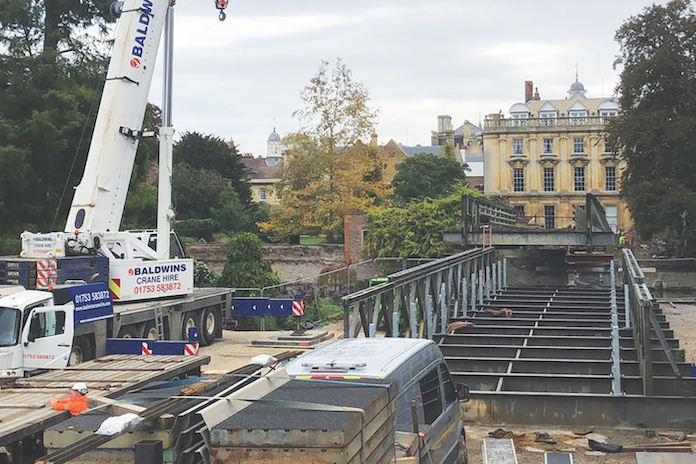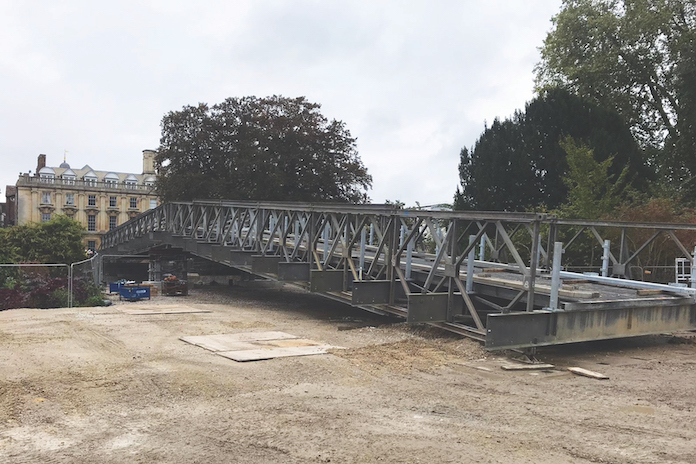Alex Drouet MCIOB, design manager with Barnes Construction, talks us through the project

We were appointed in September 2019 to deliver the pre-construction phase of works for the £12.4m extension and refurbishment works of Clare College’s Old Court buildings, which included an enabling period of 16 weeks to construct two bridges, one of which would link the Fellows’ Garden with the Master’s Garden and the working area in the North Passage.
The 57m long bridge, which was built and craned into place overnight by Mabey, now sits between the Garret Hostel Bridge and Clare College Bridge: the oldest bridge in Cambridge. This means that for the first time since the 1960s, the Middle River of the Cam between mill pond weir and Jesus Green weir has 10 bridges, rather than nine (excluding other construction works that we are unaware of, of course!) Now this phase is complete, plant and machinery will be able to access the Master’s Garden at the back of Old Court, the heart of Clare College, to start work in earnest.
We are working with an impressive consultancy team, made up of London architecture firm Witherford Watson Mann and two Cambridge-based businesses, structural engineer Smith and Wallwork and Henry Riley, which is the cost consultant and client project manager. Max Fordham will provide the services design for the main works.

Bridging the gap
The original plans included using the existing Clare Bridge – the oldest in Cambridge and a Grade I listed structure – for site access. We worked with the incumbent design team and our temporary works engineer Gawn Associates to develop an alternative proposal utilising a temporary bridge, with site access via the Fellows’ Garden.
There were huge co-ordination issues that required complex discussions and a collaborative approach from everyone from the college’s gardening committee, the environment agency, highways, planning, arboriculturists, neighbouring colleges, statutory utilities companies and archaeologists.
Our approach to this was always open and collaborative – our pre-construction team were full-time on the project from September 2019 through to August 2020.
Once on site, we encountered issues with unknown tree roots and CBR issues for the 500 tonne crane that lifted the 28m long span over the River Cam during the early hours of the morning. All issues were resolved by having clear and focused leadership, a superb supply chain with a ‘can-do’ attitude, and a dedicated site team to make it happen.
Despite having to stop works due to tree root issues, our subcontractor agreed to manually undertake the reduced dig in the Fellows’ Garden, wheelbarrowing tonnes of spoil out and tonnes of type 1 aggregate into the site to maintain programme while we waited for the tree issues to be resolved.
This was just one example of the real-time problem-solving that helped deliver the bridge lift on programme.
Another major headache included concluding the second stage pricing, and the enabling works construction during the first lockdown in April. Our supply chain was resolute and ensured we were able to deliver the second stage figure within budget, as well as the bridge lift on programme in preparation for the main demolition and substructure works progressing in November.
The project has been a once-in-a-lifetime experience, and a real-life example of true collaboration between client, professional team and contractor – and an example of how well a two-stage method of procurement works if managed and operated properly.









